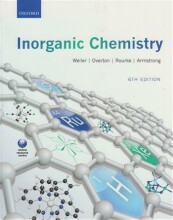Try our study magic for free
Summary: Inorganic Chemistry | 9780199641826
- This + 400k other summaries
- A unique study and practice tool
- Never study anything twice again
- Get the grades you hope for
- 100% sure, 100% understanding
a PDF, study it super fast
- No sign up, email or credit card needed!
- AI makes unlimited flashcards
- Get unlimited quizzes and tests
- Ask AI anything
- No sign up, email or credit card needed!
- Have and keep perfect overview
- Make flashcards, notes and mind maps
- Review, test and score!
Read the summary and the most important questions on Inorganic Chemistry | 9780199641826
-
1 Atomic structure
-
1.4 Penetration and shielding
This is a preview. There are 1 more flashcards available for chapter 1.4
Show more cards here -
What is the ground state electron configuration?
Ground state electron configuration is a specification of the orbital occupation of an atom in its lowest energy state. Exclusion principle forbids more than two electrons from occupying a single orbital. -
1.5 The building-up principle
-
What does the aufbau principle imply?
According to the building-up principle, orbitals of neutral atoms are treated as being occupied in the order determined in part by the principal quantum number and in part by penetration and shielding. Order of occupation: 1s 2s 2p 3s 3p 4s 3d 4p. Each orbital can accomodae up to two electrons -
5 Oxiation and reduction
-
5.2 Standard potentials and spontaineity
This is a preview. There are 2 more flashcards available for chapter 5.2
Show more cards here -
What is understood under a spontaneous reaction?
At constanttemp and pressure, the reactiongibbs energy change is negative. Delta G= -RTlnK. G<0 = k>1 -
What is an galvanic cell?
Electrochemical cell in which a chemical reaction is used to generate an electric current, in which the reaction driving the electric current through the external circuit is the reaction of interest. -
How can the potential be measured?
Delta G= -vFE E--> Standard potential. F= Faraday's constant and v= stoichiometric coefficient of the electrons transferred. -
5.4 Electrochem series
-
What does a negative standard potential signifies?
It signifies a couple in which the reduced species is a reducing agent for H+ ions under standard conditions in aq solution. -
What implies a positive E
Ox is strongly oxidizing -
5.5 Nernst eq
-
What is the reaction quotient?
A Oxa + B Redb--> RedA + B'OX B
Q= [RedA0^a'[OxB]^b'
[OXA]^a[RedB]^b
Q is the same as K(At equilibrium) -
What is the nernst equation? And when is a reaction spontaneous?
Ecell=Ecell(st.pot)-RT/vF * ln Q.
Reaction is spontaneous when Ecell >0 and G<0 -
5.6 Influence of p
This is a preview. There are 1 more flashcards available for chapter 5.6
Show more cards here -
What happens with the potential as the pH increases and the solution becomes more basic?
Potential decreases
- Higher grades + faster learning
- Never study anything twice
- 100% sure, 100% understanding
Topics related to Summary: Inorganic Chemistry
-
Oxiation and reduction - Frost diagrams
-
Molecular symmetry - Symmetry operations, elements and point groups
-
Molecular symmetry - Symmetry adapted linear combinations
-
An introduction to coordination compounds - Representative ligands
-
An introduction to coordination compounds - Low coordination number
-
An introduction to coordination compounds - Square-planar complexes
-
An introduction to coordination compounds - Tetrahedral complexes
-
D-metal complexes: Electronic structure and properties - Crystal field theory
-
Coordinatinon chemistry:reaction of complexes - ligand substitution reactions
-
D-Metal organometallic chemistry - Electron counting and oxidation states































